Sustainable Development in Gansu Province: Theil Index and Cluster Analysis
Abstract
:1. Introduction
2. Materials and Methods
2.1. Study Area
2.2. Data Sources
2.3. Research Method
2.3.1. Analysis of Development Imbalance
- Absolute Index
- 2.
- Relative Index
2.3.2. Moran’s Index
- 3.
- Global Moran’s Index
- 4.
- Local Moran’s index
2.3.3. Principal Component Analysis
2.3.4. Cluster Analysis
3. Results and Discussion
3.1. Analysis of the Characteristics of County Economic Development
3.1.1. Spatial Distribution Characteristics
3.1.2. Analysis of Spatial Correlation Characteristics
- 5.
- Global Moran’s Index
- 6.
- Local Moran’s Index
3.1.3. Analysis of Development Imbalance
- 7.
- Absolute Index
- 8.
- Relative Index
3.2. Evaluation of Sustainable Development Potential
3.2.1. The Score Analysis of the Sustainable Development of the County Economies
3.2.2. Comprehensive Score Ranking Analysis of Sustainable Development Potential of County Economies
3.2.3. Cluster Analysis of Sustainable Development Potential of County Economies in Gansu Province
3.3. Discussion
3.3.1. Discussion on County Development in Different Dimensions
3.3.2. Overall Development Discussion
4. Conclusions, Recommendations, Policy Insights, and Future work
4.1. Conclusions
- The development of county economies in Gansu Province exhibits characteristics of scattered distribution and weak communication with surrounding counties, with a pattern of multi-point flowering.
- Significant disparities exist in the economic development of Gansu Province’s counties, particularly evident in the year 2018.
- Liangzhou District emerges as the top performer in county economic development in Gansu Province. Counties with robust economic development are primarily clustered in the ‘Lanzhou–Baiyin metropolitan area’, ‘Tianshui metropolitan area’, the western entrance of the ‘Hexi Corridor economic belt’, and the Qingyang–Pingliang region, displaying a spatial pattern of agglomeration towards the middle and east.
- Southeastern Gansu shows promising potential for sustainable county economic development, with the emergence of a contiguous development pattern.
4.2. Recommendations and Policy Insights
4.3. Future Work
Author Contributions
Funding
Institutional Review Board Statement
Informed Consent Statement
Data Availability Statement
Acknowledgments
Conflicts of Interest
References
- Qiu, G.T.; Ge, J.L. On Social Development in the Post-Epidemic Era. J. Humanit. 2023, 2, 98–108. [Google Scholar]
- Wang, Y. Literature Review of China’s Economic Development in the “Post-epidemic” Era. Theor. Platf. Tibet. Dev. 2021, 3, 85–89. [Google Scholar]
- Feng, X.Y. The Evolution of China’s Sustainable Development Theory in the 40 Years of Reform and Opening Up. Mod. Manag. Sci. 2018, 6, 27–29. [Google Scholar]
- Sikos Tomay, T.; Szendi, D. Analysing economic and environmental sustainability in Hungary: How cities with county rights perform in SDGs. Urban. Izziv. 2023, 34, 87–97. [Google Scholar] [CrossRef]
- Sticking to Solving the ‘Three Rural Issues’ as the Top Priority of the Work of the Whole Party and the Whole Society to Promote Rural Revitalization. Available online: http://www.qstheory.cn/dukan/qs/2022-03/31/c_1128515304.htm (accessed on 6 December 2023).
- Gu, J.D. Urban-rural Interaction Promotes County Economic Development. Macroeconomics 2003, 4, 49–50+55. [Google Scholar]
- Zhou, M.L.; Wang, L.C. Does the Incremental Reform of Rural Finance Boost County-Level Economic Development? An Empirical Analysis of 1137 Village Banks. China Rural Surv. 2023, 6, 24–43. [Google Scholar]
- Zhang, X.L.; Zhou, Z.L.; Tang, X.Y. Several Theoretical Problems on Promoting High-quility Development of County Economy in China. Financ. Trade Res. 2023, 34, 1–8. [Google Scholar]
- Zhu, B.Q.; Li, T. Research on the impact of rural industrial integration development on county economic resilience. J. Agro-For. Econ. Manag. 2024, 4, 1–13. [Google Scholar]
- Chen, H.Y.; Zhang, Z.Y.; Du, H. The Path Choice of Structure Green Economy “Internal Cycle” facing “Double Cycle”: An Empirical Analysis of Carbon Emission Reduction Practise in GSCM of County Manufacturing Enterprises. Ecol. Econ. 2021, 37, 57–64. [Google Scholar]
- Jia, J.H.; Sun, Y.T. Policy logic and path of transition from poverty alleviation to rural revitalization. J. Zhengzhou Univ. Philos. Soc. Sci. Ed. 2022, 55, 23–28. [Google Scholar]
- Ji, Z.G.; Luo, Q.Q. The Development Context and Innovative Contribution of Xi Jinping’s Important Discussion on Rural Revitalization. Economist 2022, 4, 5–16. [Google Scholar]
- Wang, B.; Chen, Y. Research on the Development Strategy of the County Economy in Western China under the New Normal Economy. Shanghai J. Econ. 2016, 10, 76–83. [Google Scholar]
- Song, F.F.; Song, Y.P. Connotation, Characteristics and High-quality Development of County Economies--Taking Hubei as an Example. Hubei Soc. Sci. 2020, 2, 74–80. [Google Scholar]
- Dong, F. New ideas to support county economic development in the macroeconomic situation. Corp. Financ. 2022, 7, 59–60. [Google Scholar]
- Zeng, T.Y.; Jin, H.; Gang, X.; Luan, J.Y. County Economy, Population, Construction Land, and Carbon Intensity in a Shrinkage Scenario. Sustainability 2022, 14, 10523. [Google Scholar] [CrossRef]
- Li, T.L.; Li, D.Z.; Liang, D.; Huang, S.M. Coupling Coordination Degree of Ecological-Economic and Its Influencing Factors in the Counties of Yangtze River Economic Belt. Sustainability 2022, 14, 15467. [Google Scholar] [CrossRef]
- Ehlert, A. The socio-economic determinants of COVID-19: A spatial analysis of German county level data. Socio-Econ. Plan. Sci. 2021, 78, 101083. [Google Scholar] [CrossRef] [PubMed]
- Poudyal, R. COVID-19 impacts on energy systems in Nepal: Implications for SDGs. In Proceedings of the 6th SONEUK Conference, London, UK, 10 July 2021. [Google Scholar]
- Yuan, Q.W.; Chen, J.; Han, W.W.; Yang, X.J. Impact of Population Changes on County Economic Vulnerability in the Loess Plateau. Sci. Geogr. Sin. 2022, 42, 2006–2018. [Google Scholar]
- Chen, H.Z.; Zeng, B.; Guo, H. Spatial-temporal Pattern Evolution and Driving Factors of County Economy in the Yellow River Basin: Based on the Analysis of Night Light Data. Econ. Geogr. 2022, 42, 37–44. [Google Scholar]
- Liu, H.L.; Luo, N.X.; Hu, C.C. Detection of County Economic Development Using LJ1-01 Nighttime Light Imagery: A Comparison with NPP-VIIRS Data. Sensors 2020, 20, 6633. [Google Scholar] [CrossRef]
- Gibson, J.; Boe-Gibson, G. Nighttime Lights and County-Level Economic Activity in the United States: 2001 to 2019. Remote Sens. 2021, 13, 2741. [Google Scholar] [CrossRef]
- Liu, G.B.; Du, Y.H. Research on the Effects of Population Aging in Chinese County Economy. Popul. J. 2015, 37, 77–86. [Google Scholar]
- Liu, X.Y.; Ding, Z.W.; Huang, X.D.; Wang, M.; Wang, F.Z. Spatial Distribution Characteristics and Influence Factors of E-Commerce Development Level in China: Based on EDI of 1915 Counties. Econ. Geogr. 2018, 38, 11–21+38. [Google Scholar]
- He, S.W.; Liao, H.F.; Li, G.D. A spatiotemporal analysis of county economy and the multi-mechanism process of regional inequality in rural China. Appl. Geogr. 2019, 111, 102073. [Google Scholar] [CrossRef]
- Song, G.D.; Zhong, S.; Song, L.G. Spatial Pattern Evolution Characteristics and Influencing Factors in County Economic Resilience in China. Sustainability 2022, 14, 8703. [Google Scholar] [CrossRef]
- Li, Z.J.; Hu, M.J.; Wang, Z.Y. The space-time evolution and driving forces of county economic growth in China from 1998 to 2015. Growth Change 2020, 51, 1203–1223. [Google Scholar] [CrossRef]
- Ren, Y.; Gu, G.F. Temporal and Spatial Characteristics and Influencing Factors of County Economy in Northeast China. Areal Res. Dev. 2018, 37, 25–31. [Google Scholar]
- Li, Z.R.; Xu, D.Y.; Lei, S.Y.; Wang, R.Y. County economic disparity in Chengdu-Chongqing urban agglomeration. World Reg. Stud. 2018, 27, 76–85. [Google Scholar]
- Song, W. Research on the Coordinated Development of ‘Three Modernizations’ of County Economy in Central Region. Rural Econ. 2011, 5, 58–62. [Google Scholar]
- Feng, X.H.; Zhong, Y.X.; Chen, L.; Fu, Y. Evolution of Spatial Pattern of County Regional Economy in Yangtze River Economic Belt. Econ. Geogr. 2016, 36, 18–25. [Google Scholar]
- Hu, Y.; Zhang, J.X. Economic space evolution of Yangtze River Delta Group based on county scale. Econ. Geogr. 2010, 30, 1112–1117. [Google Scholar]
- Li, L.; Tian, C.H. Can the Integration of Rural Primary, Secondary and Tertiary lndustries Promote the Common Prosperity of County: Evidence from 579 Counties in the Yangtze River Economic Belt. J. Agrotech. Econ. 2024, 39, 59–75. [Google Scholar]
- Zhang, B.F.; Li, J.J.; Hu, Z.Q.; Wang, J.J.; Miao, C.H. The influence of natural endowment and political district type on the economic development of Chinese counties. Geogr. Res. 2021, 40, 2508–2525. [Google Scholar]
- Poudyal, R. Renewable Energy and Other Strategies for Mitigating the Energy Crisis in Nepal. 2021. Available online: https://cronfa.swan.ac.uk/Record/cronfa58990/Descripton (accessed on 20 January 2024).
- Oprisan, O.; Pirciog, S.; Ionascu, A.E.; Lincaru, C.; Grigorescu, A. Economic Resilience and Sustainable Finance Path to Development and Convergence in Romanian Counties. Sustainability 2023, 15, 14221. [Google Scholar] [CrossRef]
- Pan, Q.D. Research on the Mechanism of Digital Inclusive Finance to Promote the Development of County Economy. New Financ. 2023, 2, 46–55. [Google Scholar]
- Ming, L.; Yang, P.; Yang, S.G. Does County Financial Competitiveness Promote Economic Growth under the Background of High-quality Economic Development ? Rev. Investig. Stud. 2019, 38, 31–47. [Google Scholar]
- Feng, Y.Z.; Yin, Z.L.; Wang, L.G.; Mao, L.; Qiu, X.F.; Tao, Z.L.; Wu, C.X. The impacts of climate change and land use change on terrestrial ecosystem carbon storage of Gansu province from 1980 to 2020. J. Desert Res. 2023, 43, 168–179. [Google Scholar]
- Sun, J.F.; Ma, T.Y. Analysis of county economic growth and convergence under the perspective of regional coordinated development. Dongyue Trib. 2023, 12, 111–121. [Google Scholar]
- Huang, G.Q.; Zhang, S.M.; Shi, P.F. Regional Differences and Influencing Factors of the Tourism Economy in Chengdu-Chongqing Economic Circle under the Goal of Common Prosperity. J. Southwest Univ. Nat. Sci. Ed. 2023, 45, 110–122. [Google Scholar]
- Wang, Z.; Cheng, J.H.; Cheng, Z.H. Regional differences and influencing factors of tourism carbon equilibrium in China. Acta Ecol. Sin. 2021, 41, 8063–8075. [Google Scholar]
- Gedamu, W.T.; Plank-Wiedenbeck, U.; Wodajo, B.T. A spatial autocorrelation analysis of road traffic crash by severity using Moran’s I spatial statistics: A comparative study of Addis Ababa and Berlin cities. Accid. Anal. Prev. 2024, 200, 107535. [Google Scholar] [CrossRef]
- Meng, X.; Tian, M.H.; Du, L.; Ma, S. Measurement and its coordination of the development level of agricultural and rural modernization in China. Arid Land Geogr. 2024, 47, 137–146. [Google Scholar]
- Gao, H.X. Applied Multivariate Statistical Analysis; Peking University Press: Beijing, China, 2005. [Google Scholar]
- Li, B.X.; Zhang, Y.H. Comprehensive Evaluation of Urban Economic Development Potential in Hebei Province. Bus. Econ. 2022, 8, 16–18. [Google Scholar]
- Li, G.; Zhang, S.Y.; Kong, J.J. Study on influencing factors and prediction of economic development potential in Jiangsu province. J. Chang. Norm. Univ. 2020, 39, 74–81. [Google Scholar]
- Wang, Q.; Ding, Y.W.; Guo, X.M. Construction of the Indicator System of Economic High-quality Development of Counties in China. Soft Sci. 2021, 35, 115–119+133. [Google Scholar]
- Li, F.X.; Liu, D.F.; Kong, X.S.; Liu, Y.L. Multi-scenario Evaluation of County-scale Development Potential based on Shared Socioeconomic Pathways and Dynamic Simulation Approach. J. Geo-Inf. Sci. 2022, 24, 684–697. [Google Scholar]
- Yang, Z.; Zhang, X.L.; Lei, J.; Duan, Z.L.; Li, J.G. Spatio-temporal Pattern Characteristics of Relationship Between Urbanization and Economic Development at County Level in China. Chin. Geogr. Sci. 2019, 29, 553–567. [Google Scholar] [CrossRef]
- You, S.B.; Gao, Y. Construction Process and Prospect of China’s National Economic Accounting System. Stat. Decis. 2020, 36, 10–14. [Google Scholar]
- Liu, Y.C.; Liu, X.G.; Yan, Y. China ’s Macroeconomic Recovery under the Impact of Recurrent Epidemic and Structural Adjustment—China ’s Macroeconomic Report 2021–2022. Econ. Theory Bus. Manag. 2022, 42, 13–34. [Google Scholar]
- Zhang, L.; Jia, M.D. The Empirical Analysis of the Effects of Financial Expenditure and Revenue on Economic Growth. Forecasting 2009, 28, 71–76. [Google Scholar]
- Shalabi, L.A.; Shaaban, Z.; Kasasbeh, B. Data Mining: A Preprocessing Engine. J. Comput. Sci. 2006, 2, 735–739. [Google Scholar] [CrossRef]
- Zhan, D.S.; Zhang, W.Z.; Meng, B.; Dang, Y.X.; Liu, Q.Q. Spatial Structure of Urban Residence and Employment in Beijing. Sci. Geogr. Sin. 2017, 37, 356–366. [Google Scholar]
- Liao, K.H.; Chen, S.H. Identification of Spatial Development Types of Inter-City Border Towns in Guangdong Province, China. Trop. Geogr. 2022, 42, 431–443. [Google Scholar]
- Tan, M.F. Theoretical Analysis of the “High Quality Development” of County Society—Based on Sociological Perspective. Soc. Sci. Res. 2022, 6, 66–82. [Google Scholar]
- Liu, G.B.; Han, Y.T. Thoughts and Countermeasures for Realizing High-quality Development of County Economy in the New Era. Tax. Econ. 2019, 6, 55–61. [Google Scholar]
- Chen, J.S.; Ren, L. From County Competition to County Co-cooperation: The Strategic Choice of High-quality Development of County Economy. Reform 2022, 4, 88–98. [Google Scholar]

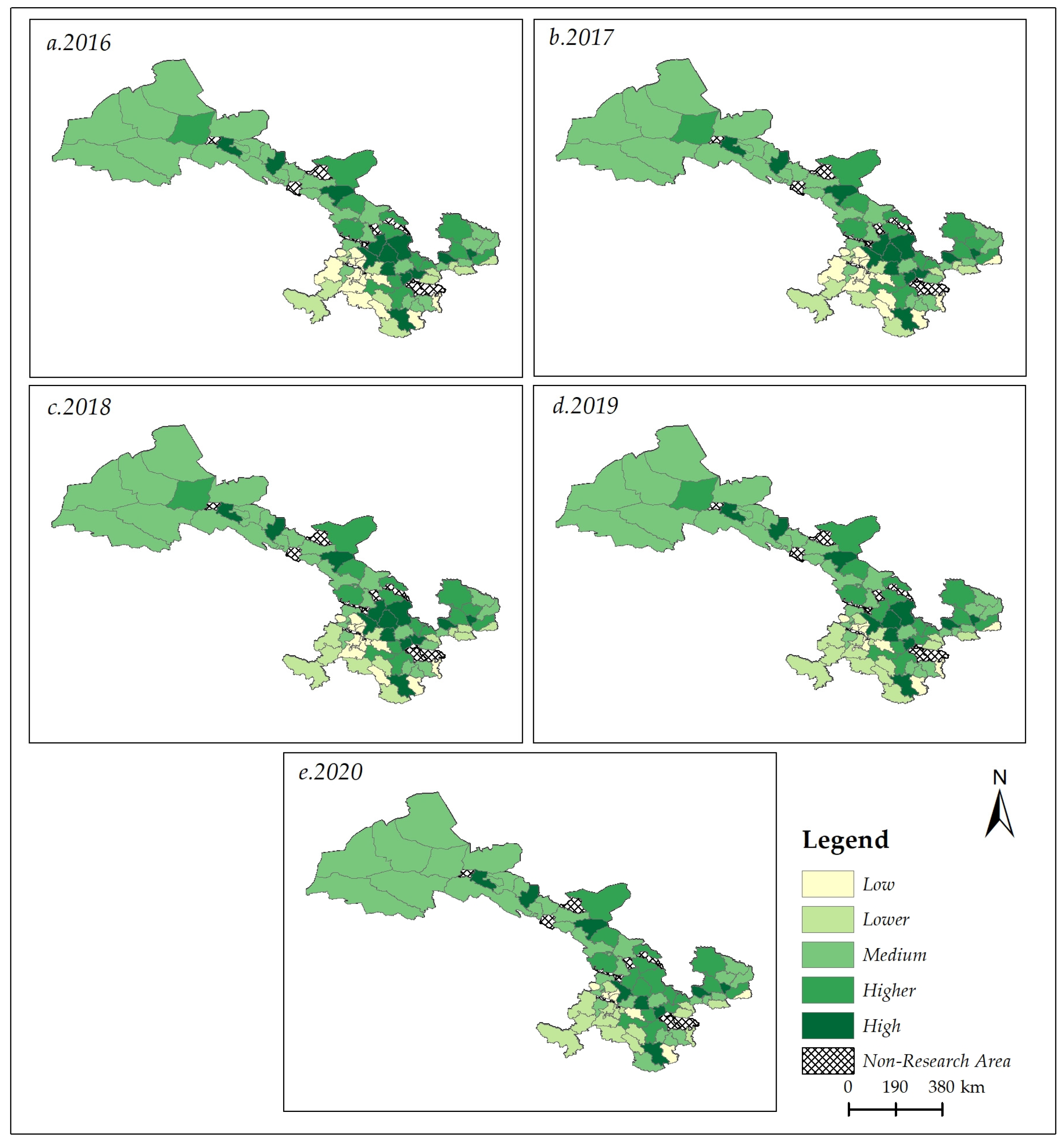
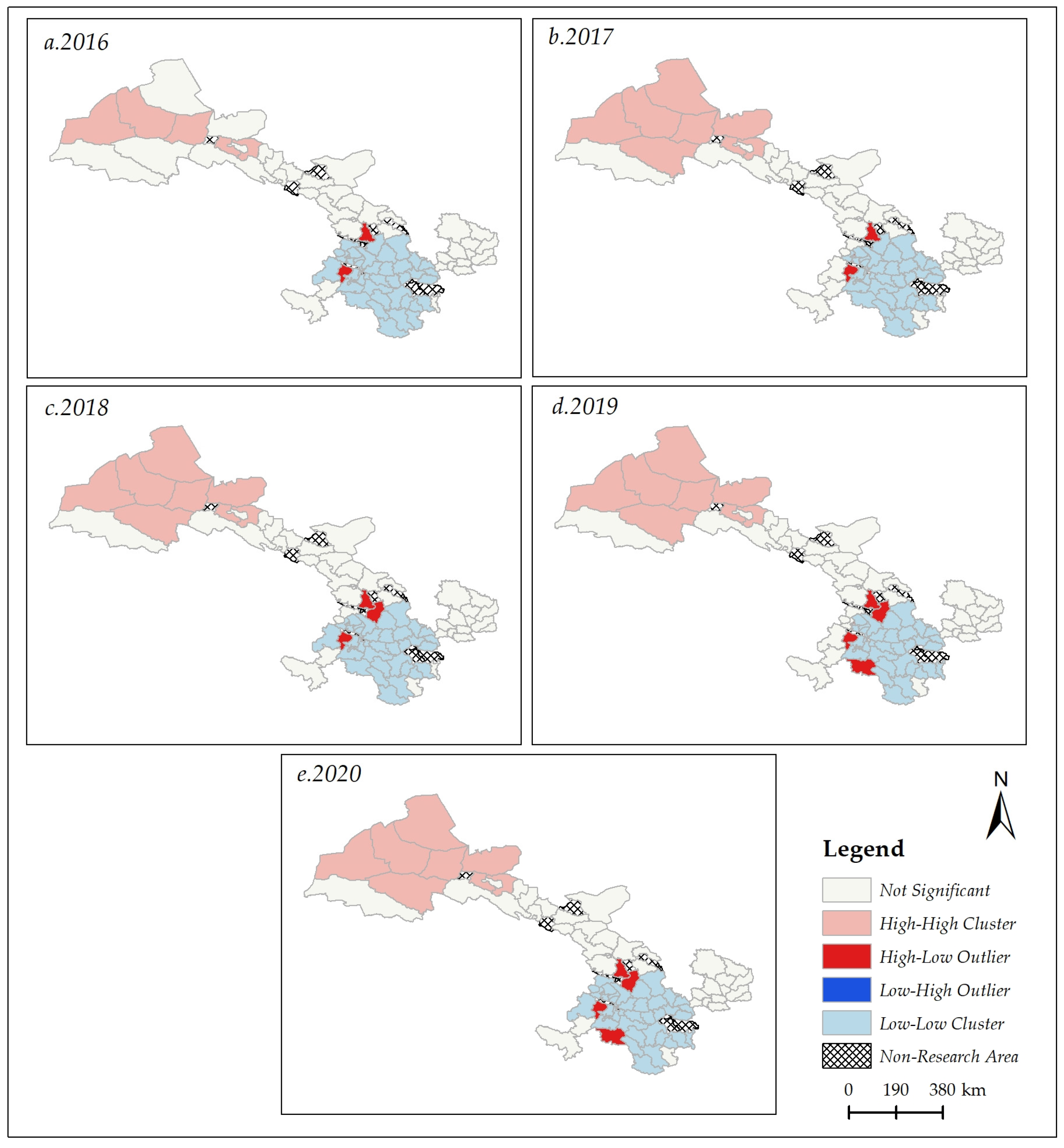
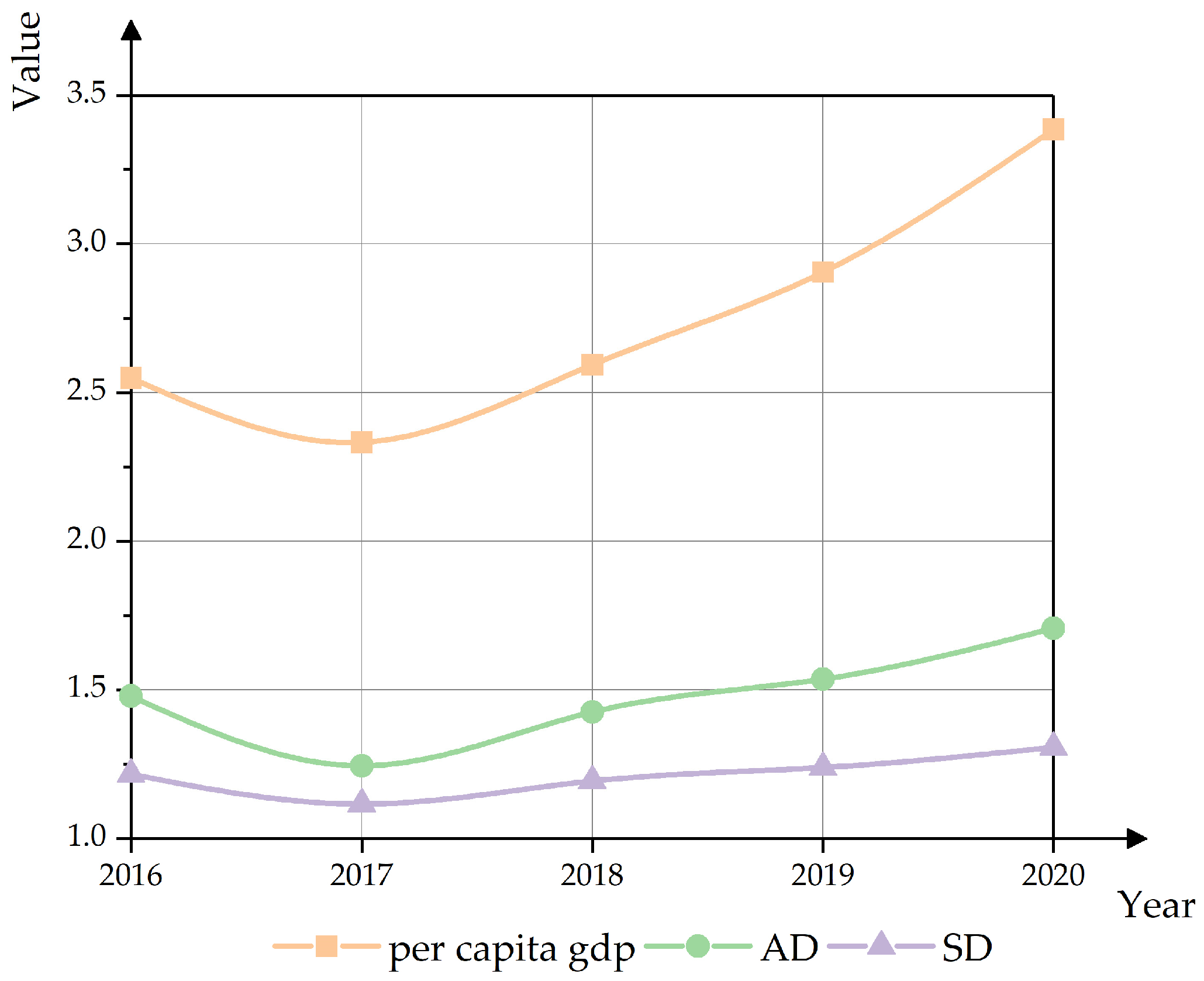
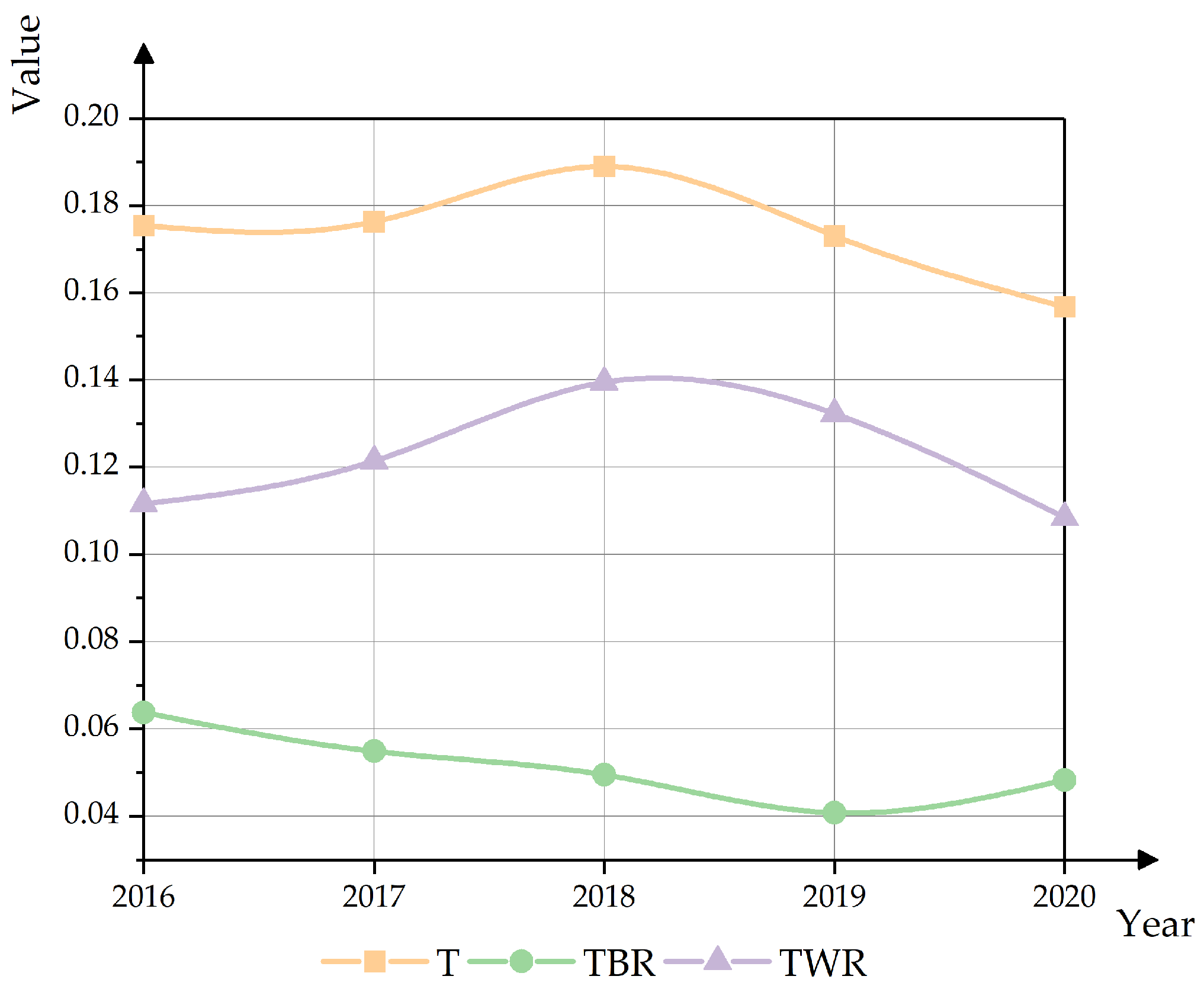
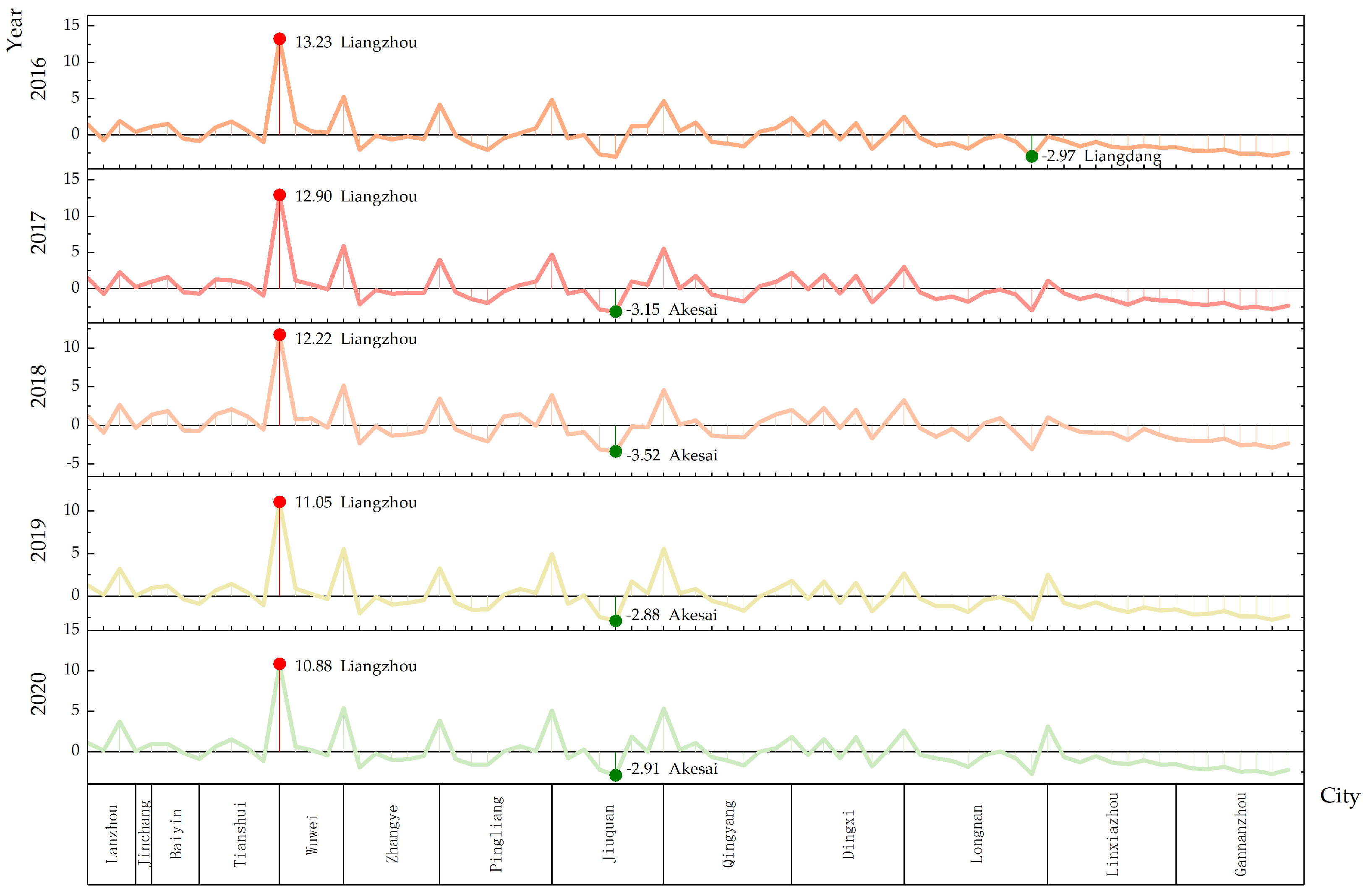

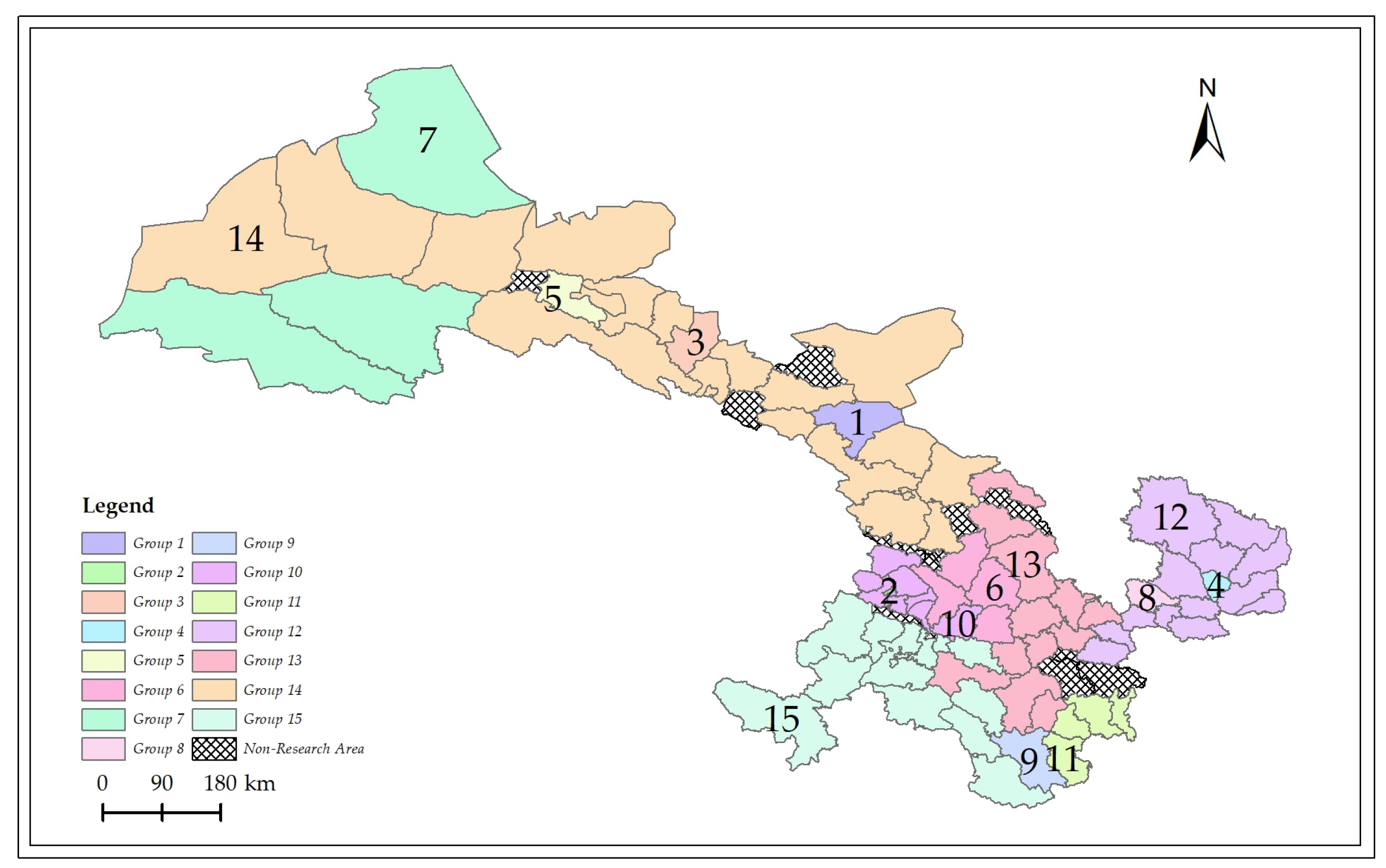
| Z-Score | p-Value | Confidence (%) |
|---|---|---|
| <−1.65 or >+1.65 | <0.10 | 90 |
| <−1.96 or >+1.96 | <0.05 | 95 |
| <−2.58 or >+2.58 | <0.01 | 99 |
| Dimension | Index | Unit | Code/X |
|---|---|---|---|
| Level of GDP Development | Gross National Product | Million CNY 1 | X1 |
| Level of Financial Development | Household Savings Deposit Balance | Million CNY | X2 |
| Loan Balance of Financial Institutions | Million CNY | X3 | |
| Level of Fiscal Development | General Public Budget Revenue | Million CNY | X4 |
| General Public Budget Expenditure | Million CNY | X5 | |
| Level of Industrial Development | The Added Value of the Primary Industry | Million CNY | X6 |
| The Added Value of the Secondary Industry | Million CNY | X7 | |
| Number of Industrial Enterprises Above the Designated Size | PCS 2 | X8 | |
| Level of Social Development | Permanent Resident Population | Million People | X9 |
| Number of Students in General Secondary Schools | People | X10 | |
| Number of Pupils in Primary Schools | People | X11 | |
| Number of Beds in Healthcare Institutions | PCS | X12 |
| Year | 2016 | 2017 | 2018 | 2019 | 2020 |
|---|---|---|---|---|---|
| Moran’s Index | 0.226 | 0.268 | 0.254 | 0.229 | 0.272 |
| Z-Score | 5.878 | 6.572 | 6.220 | 5.668 | 6.777 |
| p-Value | 0.000 | 0.000 | 0.000 | 0.000 | 0.000 |
| Year | T | TBR | TWR | T Lanzhou Economic Circle | T Hexi Corridor Economic Belt | T Longdongnan Region | ||
|---|---|---|---|---|---|---|---|---|
| Coefficient | Contribution Rate | Coefficient | Contribution Rate | |||||
| 2016 | 0.18 | 0.06 | 36.36% | 0.11 | 63.64% | 0.11 | 0.09 | 0.14 |
| 2017 | 0.18 | 0.05 | 31.12% | 0.12 | 68.88% | 0.12 | 0.08 | 0.16 |
| 2018 | 0.19 | 0.05 | 26.19% | 0.14 | 73.81% | 0.14 | 0.09 | 0.18 |
| 2019 | 0.17 | 0.04 | 23.56% | 0.13 | 76.44% | 0.14 | 0.09 | 0.16 |
| 2020 | 0.16 | 0.05 | 30.81% | 0.11 | 69.19% | 0.12 | 0.09 | 0.12 |
| County | 2016 | 2017 | 2018 | 2019 | 2020 | County | 2016 | 2017 | 2018 | 2019 | 2020 |
|---|---|---|---|---|---|---|---|---|---|---|---|
| Yongdeng | 1.51 | 1.54 | 1.28 | 1.31 | 1.08 | Huanxian | 1.72 | 1.80 | 0.70 | 0.87 | 1.07 |
| Gaolan | −0.75 | −0.72 | −0.98 | 0.13 | 0.18 | Huachi | −0.95 | −0.80 | −1.36 | −0.54 | −0.66 |
| Yuzhong | 1.93 | 2.33 | 2.77 | 3.25 | 3.76 | Heshui | −1.21 | −1.27 | −1.53 | −1.02 | −1.11 |
| Yongchang | 0.42 | 0.23 | −0.31 | 0.08 | 0.09 | Zhengning | −1.54 | −1.75 | −1.59 | −1.69 | −1.71 |
| Jingyuan | 1.12 | 1.02 | 1.43 | 1.01 | 0.99 | Ningxian | 0.45 | 0.37 | 0.48 | 0.02 | 0.02 |
| Huining | 1.56 | 1.62 | 1.95 | 1.22 | 0.98 | Zhenyuan | 0.94 | 0.95 | 1.49 | 0.84 | 0.43 |
| Jingtai | −0.52 | −0.49 | −0.69 | −0.35 | −0.16 | Anding | 2.33 | 2.20 | 2.10 | 1.83 | 1.87 |
| Qingshui | −0.82 | −0.67 | −0.73 | −0.88 | −0.90 | Tongwei | −0.08 | −0.08 | 0.26 | −0.33 | −0.42 |
| Qinan | 1.07 | 1.29 | 1.49 | 0.70 | 0.63 | Longxi | 1.89 | 1.90 | 2.35 | 1.75 | 1.58 |
| Gangu | 1.84 | 1.19 | 2.19 | 1.46 | 1.52 | Weiyuan | −0.63 | −0.65 | −0.34 | −0.75 | −0.80 |
| Wushan | 0.61 | 0.66 | 1.23 | 0.45 | 0.44 | Lintao | 1.64 | 1.83 | 2.13 | 1.59 | 1.82 |
| Zhangjiachuan | −0.97 | −0.91 | −0.54 | −1.03 | −1.11 | Zhangxian | −1.92 | −1.86 | −1.76 | −1.76 | −1.80 |
| Liangzhou | 13.23 | 12.90 | 12.22 | 11.05 | 10.88 | Minxian | 0.12 | 0.27 | 0.83 | 0.05 | 0.23 |
| Minqin | 1.66 | 1.16 | 0.82 | 0.93 | 0.65 | Wudu | 2.55 | 3.04 | 3.39 | 2.70 | 2.65 |
| Gulang | 0.51 | 0.62 | 0.95 | 0.28 | 0.20 | Chengxian | −0.39 | −0.49 | −0.37 | −0.28 | −0.37 |
| Tianzhu | 0.32 | −0.07 | −0.27 | −0.32 | −0.45 | Wenxian | −1.46 | −1.39 | −1.52 | −1.13 | −0.82 |
| Ganzhou | 5.28 | 5.90 | 5.38 | 5.54 | 5.39 | Tanchang | −1.09 | −1.07 | −0.48 | −1.12 | −1.15 |
| Sunan | −2.04 | −2.14 | −2.42 | −1.98 | −1.94 | Kangxian | −1.85 | −1.79 | −1.93 | −1.85 | −1.84 |
| Minle | −0.10 | −0.15 | −0.09 | −0.08 | −0.21 | Xihe | −0.56 | −0.54 | 0.30 | −0.42 | −0.40 |
| Linze | −0.61 | −0.67 | −1.39 | −0.96 | −1.00 | Lixian | −0.07 | −0.12 | 0.98 | −0.10 | 0.04 |
| Gaotai | −0.19 | −0.58 | −1.19 | −0.75 | −0.91 | Huixian | −0.91 | −0.81 | −0.98 | −0.74 | −0.80 |
| Shandan | −0.55 | −0.57 | −0.82 | −0.45 | −0.53 | Liangdang | −2.97 | −2.98 | −3.24 | −2.75 | −2.73 |
| Kongtong | 4.19 | 4.02 | 3.61 | 3.30 | 3.85 | linxia | −0.20 | 1.13 | 1.09 | 2.56 | 3.14 |
| Jingchuan | −0.06 | −0.47 | −0.55 | −0.77 | −0.94 | linxia | −0.78 | −0.62 | −0.08 | −0.77 | −0.63 |
| Lingtai | −1.27 | −1.42 | −1.49 | −1.56 | −1.58 | Kangle | −1.54 | −1.42 | −0.87 | −1.30 | −1.28 |
| Chongxin | −2.03 | −1.96 | −2.18 | −1.51 | −1.57 | Yongjing | −0.96 | −0.89 | −1.00 | −0.70 | −0.54 |
| Huating | −0.45 | −0.36 | 1.19 | 0.18 | 0.06 | Guanghe | −1.63 | −1.50 | −1.01 | −1.42 | −1.32 |
| Zhuanglang | 0.26 | 0.50 | 1.53 | 0.88 | 0.68 | Hezheng | −1.78 | −2.19 | −1.93 | −1.82 | −1.52 |
| Jingning | 0.97 | 1.00 | −0.07 | 0.39 | 0.07 | Dongxiang | −1.51 | −1.33 | −0.44 | −1.31 | −1.04 |
| Suzhou | 4.89 | 4.72 | 4.11 | 4.96 | 5.12 | Jishishan | −1.73 | −1.60 | −1.30 | −1.66 | −1.58 |
| Jinta | −0.45 | −0.64 | −1.22 | −0.89 | −0.83 | Hezuo | −1.70 | −1.64 | −1.92 | −1.53 | −1.55 |
| Guazhou | 0.01 | −0.22 | −0.90 | 0.12 | 0.26 | Lintan | −2.12 | −2.14 | −2.09 | −2.11 | −2.07 |
| Subei | −2.68 | −2.87 | −3.23 | −2.39 | −2.23 | Zhuoni | −2.24 | −2.16 | −2.15 | −2.08 | −2.13 |
| Akesai | −2.97 | −3.15 | −3.52 | −2.88 | −2.91 | Zhouqu | −1.98 | −1.91 | −1.76 | −1.73 | −1.84 |
| Yumen | 1.21 | 1.00 | −0.13 | 1.76 | 1.89 | Diebu | −2.59 | −2.62 | −2.64 | −2.33 | −2.45 |
| Dunhuang | 1.26 | 0.56 | −0.24 | 0.33 | 0.01 | Maqu | −2.54 | −2.48 | −2.56 | −2.37 | −2.38 |
| Xifeng | 4.67 | 5.52 | 4.77 | 5.57 | 5.36 | Luqu | −2.87 | −2.80 | −3.00 | −2.75 | −2.75 |
| Qingcheng | 0.54 | 0.00 | 0.13 | 0.33 | 0.25 | Xiahe | −2.45 | −2.32 | −2.38 | −2.28 | −2.22 |
| County | Score | Ranking | County | Score | Ranking | County | Score | Ranking |
|---|---|---|---|---|---|---|---|---|
| Liangzhou | 12.054 | 1 | Ningxian | 0.268 | 27 | Dongxiang | −1.125 | 53 |
| Ganzhou | 5.497 | 2 | Qingcheng | 0.250 | 28 | Heshui | −1.226 | 54 |
| Xifeng | 5.177 | 3 | Lixian | 0.145 | 29 | Wenxian | −1.264 | 55 |
| Suzhou | 4.758 | 4 | Huating | 0.125 | 30 | Kangle | −1.281 | 56 |
| Kongtong | 3.793 | 5 | Yongchang | 0.101 | 31 | Guanghe | −1.377 | 57 |
| Wudu | 2.865 | 6 | Minle | −0.127 | 32 | Lingtai | −1.462 | 58 |
| Yuzhong | 2.809 | 7 | Tongwei | −0.129 | 33 | Jishishan | −1.571 | 59 |
| Anding | 2.065 | 8 | Guazhou | −0.144 | 34 | Zhengning | −1.656 | 60 |
| Longxi | 1.893 | 9 | Tianzhu | −0.156 | 35 | Hezuo | −1.668 | 61 |
| Lintao | 1.804 | 10 | Xihe | −0.323 | 36 | Zhangxian | −1.817 | 62 |
| Gangu | 1.639 | 11 | Chengxian | −0.380 | 37 | Zhouqu | −1.844 | 63 |
| Linxia | 1.542 | 12 | Gaolan | −0.428 | 38 | Hezheng | −1.848 | 64 |
| Huining | 1.467 | 13 | Jingtai | −0.442 | 39 | Chongxin | −1.851 | 65 |
| Yongdeng | 1.343 | 14 | Jingchuan | −0.557 | 40 | Kangxian | −1.851 | 66 |
| Huanxian | 1.231 | 15 | Linxia | −0.575 | 41 | Lintan | −2.103 | 67 |
| Yumen | 1.145 | 16 | Shandan | −0.583 | 42 | Sunan | −2.103 | 68 |
| Jingyuan | 1.111 | 17 | Weiyuan | −0.636 | 43 | Zhuoni | −2.150 | 69 |
| Minqin | 1.043 | 18 | Gaotai | −0.725 | 44 | Xiahe | −2.328 | 70 |
| Qinan | 1.036 | 19 | Qingshui | −0.800 | 45 | Maqu | −2.467 | 71 |
| Zhenyuan | 0.930 | 20 | Jinta | −0.805 | 46 | Diebu | −2.527 | 72 |
| Zhuanglang | 0.768 | 21 | Yongjing | −0.818 | 47 | Subei | −2.679 | 73 |
| Wushan | 0.676 | 22 | Huixian | −0.847 | 48 | Luqu | −2.833 | 74 |
| Gulang | 0.512 | 23 | Huachi | −0.863 | 49 | Liangdang | −2.936 | 75 |
| Jingning | 0.471 | 24 | Zhangjiachuan | −0.909 | 50 | Akesai | −3.083 | 76 |
| Dunhuang | 0.384 | 25 | Linze | −0.926 | 51 | |||
| Minxian | 0.300 | 26 | Tanchang | −0.981 | 52 |
Disclaimer/Publisher’s Note: The statements, opinions and data contained in all publications are solely those of the individual author(s) and contributor(s) and not of MDPI and/or the editor(s). MDPI and/or the editor(s) disclaim responsibility for any injury to people or property resulting from any ideas, methods, instructions or products referred to in the content. |
© 2024 by the authors. Licensee MDPI, Basel, Switzerland. This article is an open access article distributed under the terms and conditions of the Creative Commons Attribution (CC BY) license (https://creativecommons.org/licenses/by/4.0/).
Share and Cite
Cao, P.; Tao, H. Sustainable Development in Gansu Province: Theil Index and Cluster Analysis. Sustainability 2024, 16, 4518. https://doi.org/10.3390/su16114518
Cao P, Tao H. Sustainable Development in Gansu Province: Theil Index and Cluster Analysis. Sustainability. 2024; 16(11):4518. https://doi.org/10.3390/su16114518
Chicago/Turabian StyleCao, Peng, and Haijun Tao. 2024. "Sustainable Development in Gansu Province: Theil Index and Cluster Analysis" Sustainability 16, no. 11: 4518. https://doi.org/10.3390/su16114518




